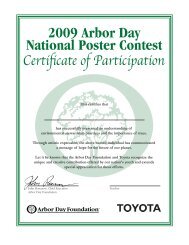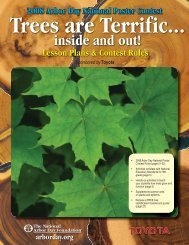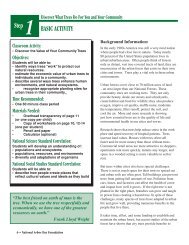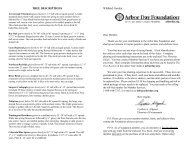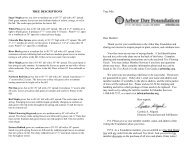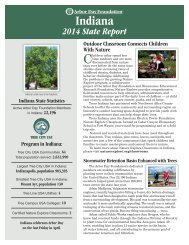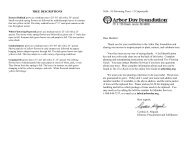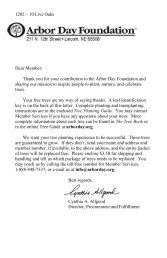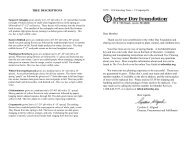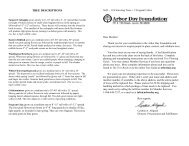Tree Diversity Activity - Arbor Day Foundation
Tree Diversity Activity - Arbor Day Foundation
Tree Diversity Activity - Arbor Day Foundation
Create successful ePaper yourself
Turn your PDF publications into a flip-book with our unique Google optimized e-Paper software.
Step 1: Discover the importance of tree diversity in a community- BASIC ACTIVITY<br />
Soil and Moisture: Each tree species can tolerate<br />
wet or dry growing conditions to a different degree.<br />
Some species do better in sandy soils. Some grow<br />
better in rocky or clay-like soils. The soil in parking<br />
lots often contains a great deal of salt from winter deicing.<br />
The salt can affect growing conditions for many<br />
kinds of trees. Honeylocust is a tree that is very<br />
tolerant of many soil conditions, as well as salt.<br />
Light: Another important environmental factor to<br />
consider is the amount of light the tree needs to grow.<br />
Some tree species, like white birch and most pines,<br />
require full sunlight to grow. Other species are more<br />
shade tolerant. Do not make the mistake of planting a<br />
tree where it is mismatched with its need for light.<br />
Air pollution: Chemicals in the air vary from<br />
location to location. Some trees are more tolerant than<br />
others of air pollution.<br />
Have students look at the "Key To Ideal Site<br />
Conditions" at the bottom of their worksheet.<br />
Ask students to identify a tree that requires full<br />
sun... one that is shade tolerant. Select a tree that<br />
requires a wet soil to grow... one that is tolerant of<br />
many different soil conditions.<br />
Concept #4: A greater diversity of trees means a<br />
greater diversity of wildlife.<br />
<strong>Tree</strong>s play an important role in the web of life that<br />
exists in a rural or urban forest. They provide food<br />
and shelter to a variety of wildlife. Certain tree<br />
species can determine the insect, bird, and even some<br />
mammal populations that exist in an area. Without<br />
that tree, the dependent organism would not be<br />
present.<br />
Proper selection of trees and plants can provide<br />
beauty and shade and, at the same time, provide a<br />
haven for wildlife. The presence of wildlife can make a<br />
backyard or woodlot a special place for your family. As<br />
urban and suburban development displaces many<br />
birds and animals from their natural habitat, it<br />
becomes increasingly important for landowners to<br />
provide mini-sanctuaries for wild birds and other<br />
wildlife. Some of the basics to consider when planting<br />
for wildlife include:<br />
Provide food: a wide variety of trees with high food<br />
value is the single best way to increase your wildlife<br />
viewing pleasure. Students should be reminded that<br />
when planting for wildlife, think about a variety of<br />
trees that will offer food for the animal year round.<br />
• Summer Fruit - Cherries, Dogwoods, Plums,<br />
Apricots<br />
• Fall and Winter Fruit - Apples, crabapples,<br />
Dogwoods, Hackberry, Hawthorn, Mountain ash<br />
• Seeds - Ashes, Birches, Firs, Hemlock, Maples,<br />
Spruces, Sweetgum<br />
• Nuts and Acorns - Butternut, Walnut, Chestnut,<br />
Hazelnut, Hickory, Oaks, Pecan<br />
Provide cover: Birds and small animals need<br />
concealed spaces for nesting and hiding to protect<br />
them from the eyes of predators. Planting conifers in<br />
groups, growing hedges with low branches, or using<br />
prickly or thorny plants in a<br />
few areas are all ways to<br />
provide wildlife cover.<br />
Using their worksheet,<br />
have students identify some<br />
of the tree species that are<br />
beneficial to wildlife.<br />
Ask students what kinds<br />
of wildlife they would like to<br />
attract . What are some<br />
benefits and disadvantages<br />
of attracting wildlife.?<br />
An example could include<br />
the fun of bringing many<br />
bird species to your backyard<br />
versus attracting large<br />
numbers of birds to city<br />
streets where bird droppings<br />
get on parked cars and<br />
business signs.<br />
National <strong>Arbor</strong> <strong>Day</strong> <strong>Foundation</strong> •



